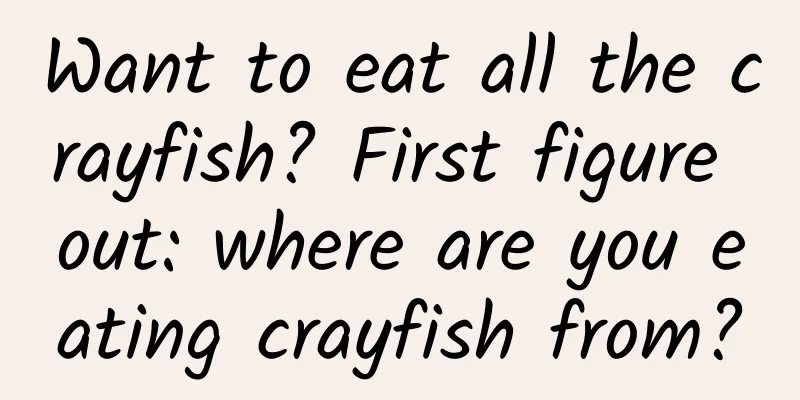Want to eat all the crayfish? First figure out: where are you eating crayfish from?

|
Recently, although the temperature has repeatedly challenged people's "bottom line", it still cannot stop foodies from yearning for the roadside stalls' "beer + crayfish". You can often see such a statement on the Internet: crayfish only like to live in heavily polluted stinking ditches, and like to eat rotten dirt. They contain a large amount of heavy metals and other toxic substances and pathogens and parasites in their bodies, and are not suitable for consumption . So, are the crayfish sold on the market really so dirty? Is it safe to eat crayfish? 01 The “invading” wild crayfish is indeed “hateful” The official Chinese name of crayfish is Procambarus clarkii, which is native to freshwater rivers, lakes, ponds and swamps in the southeastern United States and northern Mexico. It was introduced to China by the Japanese as bullfrog feed around 1930. It was transferred from Japan to China in 1929. Around the beginning of the 21st century, the edible value of crayfish was gradually developed and began to become the "new favorite" in the field of aquaculture. By 2019, China has become the world's largest producer and consumer of crayfish, with Hubei Province having the most developed crayfish farming industry. Staff are screening crayfish. (Source: Xinhua News Agency) In the wild of our country, naturally bred crayfish have also established a foothold and even caused biological invasion problems in some areas. We often see this statement: Chinese people eat so many crayfish every year that they can eat them all out! However, no alien invasive species can be completely controlled by "eating" alone. Scientific and technical personnel are showing crayfish (Source: Xinhua News Agency) Most of the crayfish we eat come from artificial breeding, not from the wild. In the wild, crayfish have strong adaptability and reproduction ability. When they are in sewage with extremely low dissolved oxygen , they can climb out of the water and breathe air into their gills; they can also climb onto land and migrate from one body of water to another; even if the pond they inhabit dries up, they can dig holes in the mud and hide in them for up to 4 months until the rain comes again. Crayfish have a very diverse diet and will eat anything, including dead animals and organic debris in the water. They also prey on eggs and larvae of native fish, eggs and tadpoles of native amphibians, aquatic vegetation, and may even enter paddy fields and destroy rice seedlings . Source: Xinhua News Agency Crayfish's habit of digging holes also means they may cause damage to paddy fields and fish ponds , and even destroy water conservancy facilities such as earthen dams , causing pipe bursts and dam breaches . Crayfish can also carry and spread infectious diseases such as white spot disease , which have a high mortality rate to native freshwater shrimp, crabs and other crustaceans. These crayfish that have invaded China's wild natural water bodies have posed a considerable threat to the balance of freshwater ecology, the diversity of native species and human production and life in some local areas. We should pay attention to and control their invasion and spread. It is generally not recommended to eat crayfish living in the wild (especially in polluted waters). If they are caught, they can be disposed of in other ways, such as killing them and using them as animal feed or organic fertilizer . 02 Crayfish living in clean water are not "demons" The fact that crayfish can tolerate heavily polluted water does not mean that they can only live in dirty water. In fact, those crayfish that live in clean water with sufficient dissolved oxygen have a much stronger growth rate and disease resistance than those that live in dirty water. Eating carrion is not a habit unique to crayfish. In addition to crayfish, wild crabs (including the Chinese mitten crab, commonly known as the hairy crab), eels, as well as turtles and snails are also "scavengers" in the water and will swallow animal carcasses and rotten organic matter in the water. Parasites are not exclusive to crayfish. Almost all freshwater fish, amphibians, mollusks, etc. that we come into contact with in our lives can carry parasites that can infect the human body to a greater or lesser extent. Villagers load crayfish into trucks and send them to the market for sale. (Source: Xinhua News Agency) In fact, as long as the water environment in which they grow is clean, crayfish is no different from other aquatic products. Generally speaking, the edible crayfish sold in the market must be strictly supervised and quarantined by relevant departments before they can be put on the market. As long as they are properly handled and thoroughly cooked before cooking, they are generally safe to eat. There is no need to panic because of some unfounded rumors on the Internet. 03 How to eat crayfish? It’s a science! So, how should we eat crayfish correctly? Remember the following 4 principles : Cooked crayfish (copyright image from the gallery, reprinting may cause copyright disputes) ▶Removal principle In addition to scrubbing the crayfish several times before cooking to remove the mud and other debris attached to its body surface, the crayfish's digestive tract (commonly known as the "shrimp thread") contains semi-digested food and feces, which should also be removed. The hepatopancreas (the soft yellow-brown tissue near the reproductive glands commonly known as "shrimp roe") inside the cephalothorax is also not suitable for consumption. ▶15-minute principle The cooking time for crayfish should be at least more than 15 minutes to cook it thoroughly and kill any pathogens it may carry. ▶No eating principle The "don't eat" here means don't eat dead or unknown crayfish to avoid food poisoning. ▶Moderation principle Excessive consumption of crayfish may cause Haff disease and lead to rhabdomyolysis, so it is not recommended for sensitive people to consume excessive amounts of crayfish. summary In short, as long as the source of crayfish is clean and hygienic, and the processing method and consumption amount are proper, we can enjoy the happiness brought to us by this summer delicacy. Author: Hu Kai, science research instructor, CCTV-9 documentary channel science consultant Reviewer: Yu Fandong, member of the popular science expert team of the Chinese Society of Fisheries, PhD of the Pearl River Fisheries Research Institute of the Chinese Academy of Fishery Sciences Produced by: Science Popularization China The cover image of this article is a copyrighted image of the gallery. Reprinting and using it may lead to copyright disputes. |
<<: How important is a perky butt to athletes? There are so many benefits to having a strong butt!
>>: Examinations for breast diseases
Recommend
What causes lower abdominal pain on the right side of a woman
Abdominal pain is a common disease in our daily l...
Tips for breast enhancement after weaning, these methods will make you firmer!
After a period of breastfeeding, women's brea...
These tips will help you relieve "holiday syndrome" and recover quickly
Holiday syndrome refers to the difficulty people ...
Are adnexitis and pelvic inflammatory disease serious?
Adnexitis and pelvic inflammatory disease are two...
What to eat for back pain? These four are preferred
Back pain is a condition that many people have en...
To make matters worse, why is Sange so miserable?
According to a report by the Global Times, as Ind...
Why do women have gynecological diseases?
In life, many women are troubled by gynecological...
Normal development age of little girls
Puberty refers to the physiological development p...
What are the symptoms of an incomplete abortion?
Many women will go to the hospital for curettage ...
Can I get pregnant if I have sex ten days after an abortion?
Pregnant women are always very sensitive during p...
Symptoms of first menstruation after IUD removal
There is a certain connection between menstruatio...
When is the right time to have an abortion?
Painless abortion is not unfamiliar to everyone, ...
What to do if breast hyperplasia is benign?
There are many cases of breast hyperplasia in cli...
Tips for toe pain from wearing high heels
Many female friends prefer to wear high heels in ...
Dysmenorrhea, anal pain, and the urge to poop
Menstrual pain caused by various reasons may caus...









